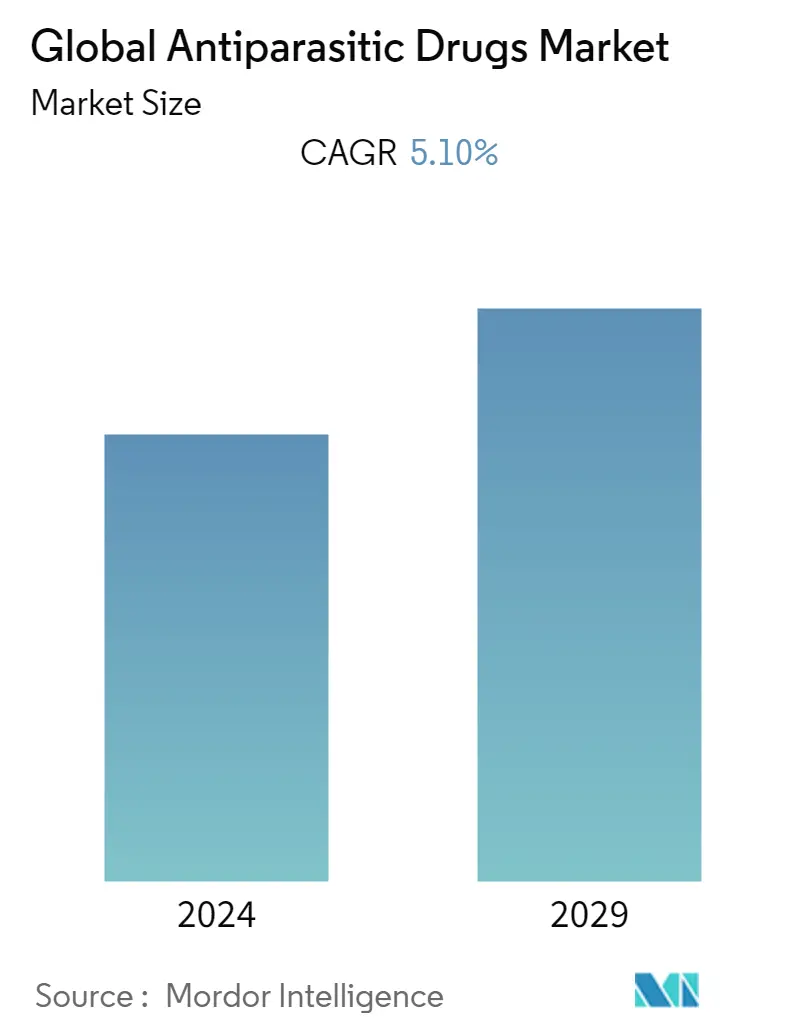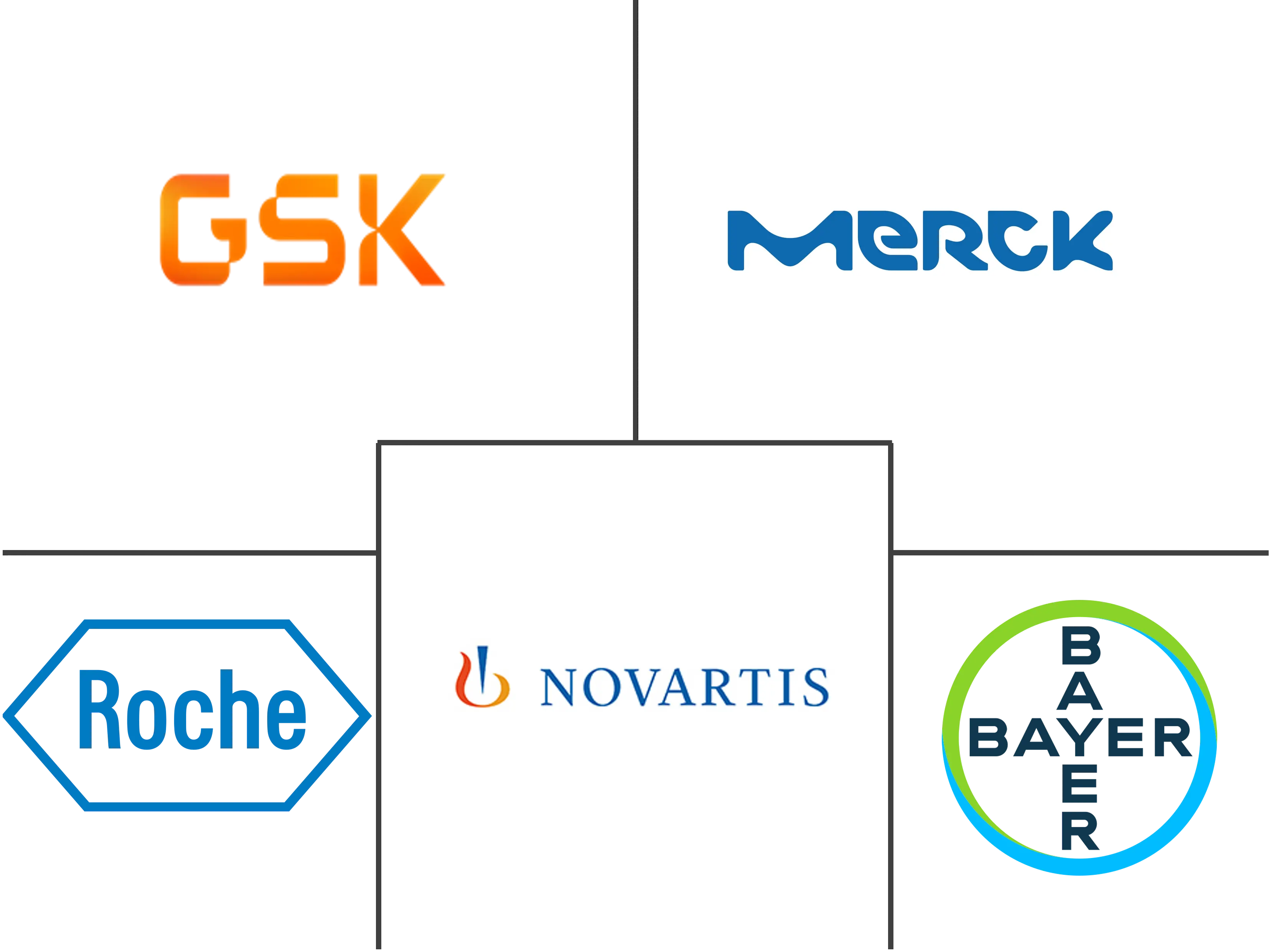Market Size of Global Antiparasitic Drugs Industry

| Study Period | 2019 - 2029 |
| Base Year For Estimation | 2023 |
| Forecast Data Period | 2024 - 2029 |
| CAGR | 5.10 % |
| Fastest Growing Market | Asia-Pacific |
| Largest Market | North America |
Major Players
*Disclaimer: Major Players sorted in no particular order |
Need a report that reflects how COVID-19 has impacted this market and its growth?
Anti-Parasitic Drugs Market Analysis
The antiparasitic drugs market is projected to grow with a CAGR of 5.1% during the forecast period (2022 - 2027).
The COVID-19 outbreak has had a significant impact on the market. As employment closures have curtailed import and export activities, there has been a considerable influence on the market, resulting in shortages and unavailability of antiparasitic drugs and supplies across healthcare facilities. Due to the temporary shutdown of production facilities, export restrictions, increased demand for the COVID-19 medication, disruptions in the supply of goods, and interruptions in services, the impact of the outbreak in its initial phase on the antiparasitic drugs market was substantial. As per the data published by the World Health Organization (WHO), in 2020, most malaria-endemic countries faced moderate disruptions in anti-parasitic service delivery. However, the demand for treating COVID-19 with different drugs, such as antiviral and anti-parasitic, witnessed a significant boost in 2021. Clinical trials were undertaken to observe the effect of these drugs on novel coronavirus. For instance, according to the National Center for Biotechnology Information article titled "From hydroxychloroquine to Ivermectin: What are the Antiviral Properties of Anti-Parasitic Drugs to Combat SARS-CoV-2", published in February 2021, it was observed that chloroquine, hydroxychloroquine, artemisinins, and nitazoxanide showed some antiviral activity in vitro studies to reduce the viral replication stage by affecting cellular organelles.
Furthermore, according to the research study published by the British Heart Foundation, in April 2021, titled "Antiparasitic Drug Could Prevent Covid-19 Lung Damage," it was concluded that Niclosamide could protect cells against COVID-19-induced cell death. As per the same source, researchers observed that mefloquine demonstrates antiviral activity against coronaviruses by inhibiting the cytopathic effect of two coronaviruses closely related to SARS-CoV-2- the pangolin coronavirus GX_P2V/pangolin and feline coronavirus. The most effective drug among the anti-parasitic drug classes was Ivermectin, which was approved by the United States Food and Drug Administration (FDA) for therapeutic use among coronavirus patients. Likewise, according to the National Center for Biotechnology Information data, in April 2021, it was found that Ivermectin, an anti-parasitic drug, inhibited the SARS-CoV-2 virus growth by removing all the viral RNA from growing in cell culture within 48 hours. Therefore, initially, the growth of the anti-parasitic drugs market was hampered due to the government's restrictions on the COVID-19 pandemic. However, the market is anticipated to gain traction due to the increasing demand for antiparasitic drugs for treating COVID-19 patients and the growth in the number of drug trials for COVID-19 treatment.
Furthermore, major factors contributing to the growth of the antiparasitic drug market include the increasing prevalence of parasitic infections such as Chagas Disease, the surge in research and development activities of companies to launch antiparasitic drugs, and the initiatives taken by the government and non-profit groups to raise public awareness of parasitic infections and provide appropriate treatment. For instance, according to the World Health Organization (WHO) updates from April 2022, around 6-7 million people were diagnosed with Chagas Disease, a parasitic infection caused by the Trypanosoma cruzi parasite. Moreover, the World Health Organization announced a series of guidelines in June 2020 to control a parasitic neglected tropical disease, Schistosomiasis, to eliminate it as a public health problem by 2025 and make the world a "World Free Schistosomiasis."
In addition, the rising research and development activities and an increasing number of company collaborations for developing product pipelines are providing beneficial opportunities for the antiparasitic drugs market over the forecast period. For instance, in April 2021, Janssen Pharmaceutica NV collaborated with WEHI, an Australian Medical Research Center, to develop potential new antimalarial drug candidates. The collaborative research team discovered compounds with antimalarial activity within a collection of 80,000 drug-like molecules in the Janssen Jump-stARter Compound Library. The researchers towards potential antimalarial drugs are further developing the most promising candidates. Moreover, in May 2021, Bajaj Healthcare launched its new anti-parasitic drug, Ivejaj, which can be used to treat COVID infections. The company has received approval from India's drug regulator, DCGI, to manufacture and market the tablets. Additionally, in April 2021, Janssen Pharmaceutica NV collaborated with an Australian medical research institute, WEHI, to develop potential new antimalarial drug candidates. A collaborative research team discovered compounds with antimalarial activity within a collection of 80,000 drug-like molecules in the Janssen Jump-stARter Compound Library. The researchers towards potential antimalarial drugs are further developing the most promising candidates.
However, the adverse effects and risks associated with anti-parasitic drugs and a lack of awareness among the rural population in developing and underdeveloped economies are expected to hamper the growth of the antiparasitic drugs market.
